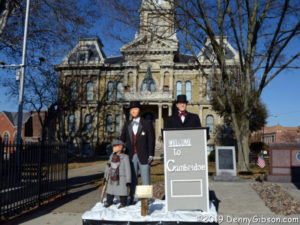 Like the one a fortnight earlier, last Sunday was preceded by a very blog-worthy Saturday that just had to wait because the weekly blog slot was already filled. Again, I’m calling that good since it gave me all week to produce this post rather than trying to put it together overnight. If I had, it’s certain that it would contain fewer pictures and more mistakes. The actual target of my trip was Zanesville, Ohio, but that’s close enough to Cambridge that I drove over to visit the annual Dickens Victorian Village. As things turned out, Cambridge and the figures that line its streets during the holidays get almost the entire post.
Like the one a fortnight earlier, last Sunday was preceded by a very blog-worthy Saturday that just had to wait because the weekly blog slot was already filled. Again, I’m calling that good since it gave me all week to produce this post rather than trying to put it together overnight. If I had, it’s certain that it would contain fewer pictures and more mistakes. The actual target of my trip was Zanesville, Ohio, but that’s close enough to Cambridge that I drove over to visit the annual Dickens Victorian Village. As things turned out, Cambridge and the figures that line its streets during the holidays get almost the entire post.
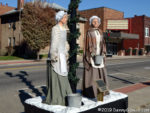
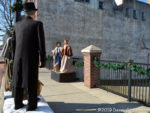
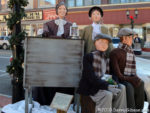 There are nearly 200 of the life-sized figures. Each is unique and dressed in Victorian-era clothing. They are grouped into 90-some scenes. Some come directly from a Charles Dickens story while others represent sights the author might have encountered walking around nineteenth-century England.
There are nearly 200 of the life-sized figures. Each is unique and dressed in Victorian-era clothing. They are grouped into 90-some scenes. Some come directly from a Charles Dickens story while others represent sights the author might have encountered walking around nineteenth-century England.
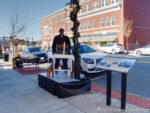
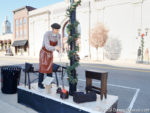
 This is the village’s fourteenth year, and I believe this is at least the fourth time I’ve visited. The bulk of the figures are placed along Wheeling Avenue which once carried the National Road. The road and a bridge pictured on that panel will be mentioned again before this article ends.
This is the village’s fourteenth year, and I believe this is at least the fourth time I’ve visited. The bulk of the figures are placed along Wheeling Avenue which once carried the National Road. The road and a bridge pictured on that panel will be mentioned again before this article ends.
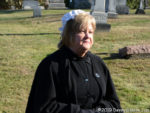
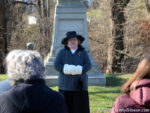
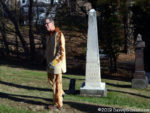 The Guernsey County Historical Society offered two “living” tours of Cambridge’s Old City Cemetery and I made it to the second one. The first resident we met was Sophia Gibout, Sophia was a washerwoman who died in 1865 after living in Cambridge for many years. Being familiar with other residents — both before and after their move to the cemetery — she accompanied us as a guide. The lady with the white muff is Elizabeth Taylor, wife of Joseph Taylor. The Taylors figured prominently in Cambridge’s early history. A newspaper and hotel were among their contributions and Joseph served in the U.S. House of Representatives. Isaac Oldham, the fellow in the third photo, settled in the area before Cambridge was established.
The Guernsey County Historical Society offered two “living” tours of Cambridge’s Old City Cemetery and I made it to the second one. The first resident we met was Sophia Gibout, Sophia was a washerwoman who died in 1865 after living in Cambridge for many years. Being familiar with other residents — both before and after their move to the cemetery — she accompanied us as a guide. The lady with the white muff is Elizabeth Taylor, wife of Joseph Taylor. The Taylors figured prominently in Cambridge’s early history. A newspaper and hotel were among their contributions and Joseph served in the U.S. House of Representatives. Isaac Oldham, the fellow in the third photo, settled in the area before Cambridge was established.


 The American Civil War was naturally a major chapter in the history of Cambridge and these three figures have some interesting personal connections to it. Before serving in the war, James Adair walked to California to join the gold rush of 1849, made his fortune in the goldfields, then returned to Ohio by taking a ship south to the isthmus of Panama, traveling across it, and heading north on another ship. Captain Adair was killed in Virginia in 1962 and his body returned to Cambridge for burial. John Cook was killed by an unknown assailant in March of 1865. The murderer and an accomplice were eventually tracked down and a major trial, which overlapped that of Lincoln’s assassins, resulted in both being hanged. The gentleman in the tophat is C.P.B. Sarchet. He survived the war after reaching the rank of colonel then developed a reputation as a great historian. He was born in 1828 which he proudly pointed out was the same year that the National Road came through and that double covered bridge on the panel downtown was built. The bridge stood until washed away by the flood of 1913. Colonel Sarchet died a few weeks later.
The American Civil War was naturally a major chapter in the history of Cambridge and these three figures have some interesting personal connections to it. Before serving in the war, James Adair walked to California to join the gold rush of 1849, made his fortune in the goldfields, then returned to Ohio by taking a ship south to the isthmus of Panama, traveling across it, and heading north on another ship. Captain Adair was killed in Virginia in 1962 and his body returned to Cambridge for burial. John Cook was killed by an unknown assailant in March of 1865. The murderer and an accomplice were eventually tracked down and a major trial, which overlapped that of Lincoln’s assassins, resulted in both being hanged. The gentleman in the tophat is C.P.B. Sarchet. He survived the war after reaching the rank of colonel then developed a reputation as a great historian. He was born in 1828 which he proudly pointed out was the same year that the National Road came through and that double covered bridge on the panel downtown was built. The bridge stood until washed away by the flood of 1913. Colonel Sarchet died a few weeks later.

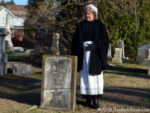 We walked back to where we had first met Sophia and where Elizabeth was waiting. Like Paul Harvey, Elizabeth wanted to make sure we knew the rest of Sophia’s story. She was well-liked in the town and at her death friends arranged for a proper burial. It was then that the undertaker discovered that the washerwoman was physically a man. That simple revelation ended the “living” tour and started some personal brain activity. I’ve read of nineteenth-century women disguising themselves as men in order to join the military, drive a stagecoach, or participate in some other activity otherwise denied them. This was something different. There are essentially no reasons that would justify choosing to live as a lower-class female in the early 1800s. Sophia Gibout’s story should make anyone who believes that questions of gender identity are a 21st-century phenomenon think just a little deeper.
We walked back to where we had first met Sophia and where Elizabeth was waiting. Like Paul Harvey, Elizabeth wanted to make sure we knew the rest of Sophia’s story. She was well-liked in the town and at her death friends arranged for a proper burial. It was then that the undertaker discovered that the washerwoman was physically a man. That simple revelation ended the “living” tour and started some personal brain activity. I’ve read of nineteenth-century women disguising themselves as men in order to join the military, drive a stagecoach, or participate in some other activity otherwise denied them. This was something different. There are essentially no reasons that would justify choosing to live as a lower-class female in the early 1800s. Sophia Gibout’s story should make anyone who believes that questions of gender identity are a 21st-century phenomenon think just a little deeper.
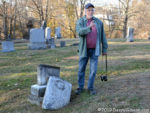 Following the “living” tour, a presentation on tombstone symbols was provided by Randy Neff of the Guernsey County Genealogical Society. In the photo, Randy is standing beside a tombstone showing a pair of hands. The hand on the viewer’s left represents the deceased. It is always stiff and lifeless and is gripped by the other hand which may represent an already deceased spouse or other relative. A hand coming from a cloud represents the hand of God himself pulling the newly deceased into Heaven.
Following the “living” tour, a presentation on tombstone symbols was provided by Randy Neff of the Guernsey County Genealogical Society. In the photo, Randy is standing beside a tombstone showing a pair of hands. The hand on the viewer’s left represents the deceased. It is always stiff and lifeless and is gripped by the other hand which may represent an already deceased spouse or other relative. A hand coming from a cloud represents the hand of God himself pulling the newly deceased into Heaven.
It was now that l realized my great blunder. I had driven to the area for the purpose of attending a gathering of the Ohio National Road Association. It was on my phone calendar for 7:00 PM. As I left the cemetery, I considered driving the short distance east to Wheeling, West Virginia, where one of my favorite bridges had recently been closed. I can’t explain why I only now double-checked the phone calendar with the original ONRA mailing, but that’s what I did. My intent was to determine with certainty whether or not if I had time to drive to Wheeling and back to Zanesville. What I discovered was that the information on my phone was terribly wrong. The gathering was a 12:00 lunch, not a 7:00 dinner. I had plenty of time to drive to Wheeling because I had already completely missed the event.

 The 1849 Wheeling suspension bridge was closed in late September due to continuing violations of weight limits. I didn’t expect to discover anything new but my basic curiosity prompted me to take a look since I was fairly close. The result is a picture of a bridge closed sign.
The 1849 Wheeling suspension bridge was closed in late September due to continuing violations of weight limits. I didn’t expect to discover anything new but my basic curiosity prompted me to take a look since I was fairly close. The result is a picture of a bridge closed sign.
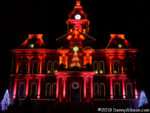
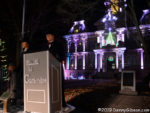 Anticipating an evening spent with National Road fans near Zanesville, I had a motel reserved nearby. The sun set while I was in Wheeling which gave me an opportunity to stop in Cambridge for a look at the wonderful light show at the Guernsey county courthouse.
Anticipating an evening spent with National Road fans near Zanesville, I had a motel reserved nearby. The sun set while I was in Wheeling which gave me an opportunity to stop in Cambridge for a look at the wonderful light show at the Guernsey county courthouse.
